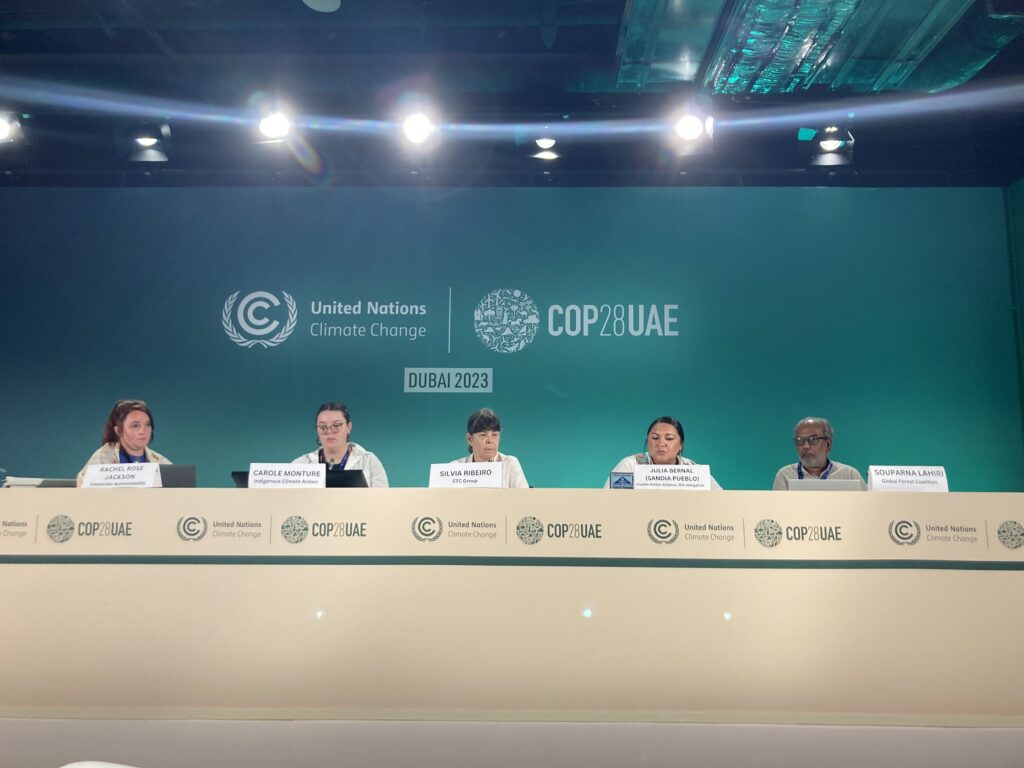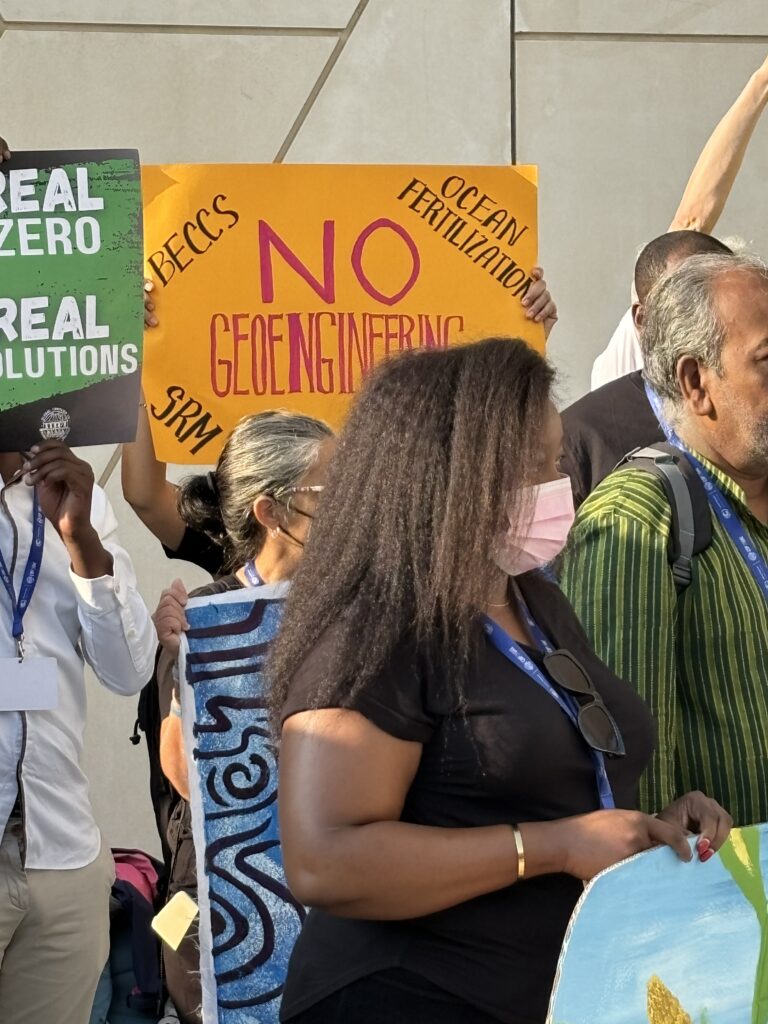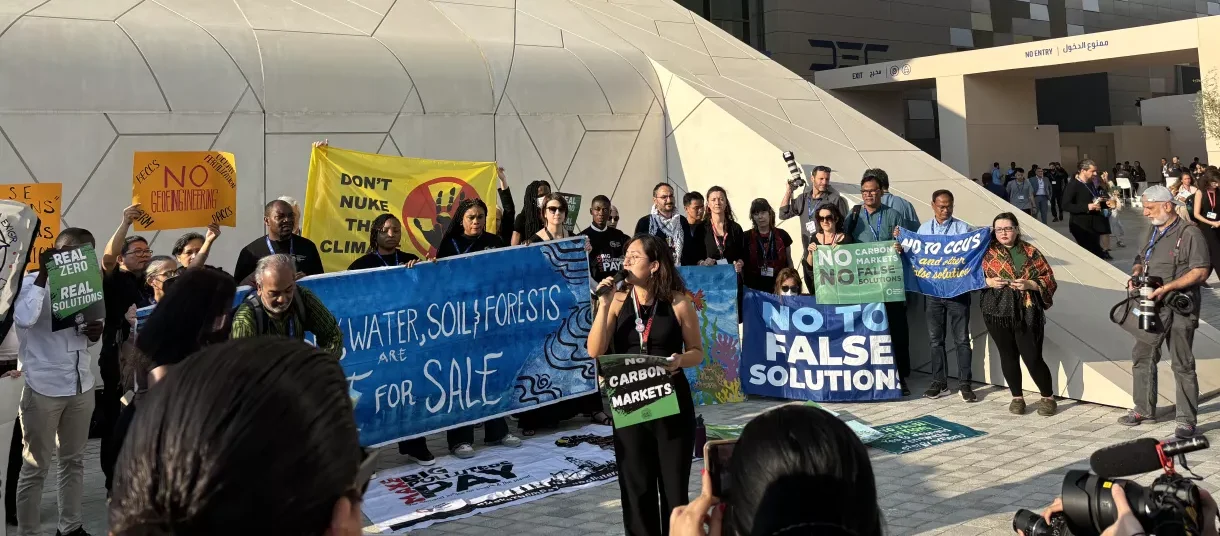The latest Conference of the Parties under the United Nations Framework Convention on Climate Change (COP 28) was held between November 30 and December 12, 2023, in Dubai, United Arab Emirates. While interpretations of the results might be mixed, the key message for climate action remains the same: climate policy stands at a crossroads and our societies need to massively and rapidly reduce emissions of carbon dioxide and other greenhouse gases in a globally just manner. In addition, these emission reductions are possible if the right policies are taken. However, many Global North countries have not only evaded their responsibilities as main polluters but also tried to push for geoengineering technologies as possible future climate policy options. Solar geoengineering or solar radiation modification (SRM) is one such technology.
The basic idea behind this set of speculative technologies is to artificially intervene in planetary systems to reflect parts of the incoming sunlight, which could reduce average global temperatures. Various alternative terms are used, such as “solar radiation management”, “climate protection technologies”, or” “albedo modification”. Some scientists suggest injecting massive amounts of sulphate aerosols into the stratosphere through special aircraft or balloons. Theoretically, some models predict that these tiny particles could bounce some sunlight back into outer space and artificially lower global mean temperatures as long as the technology is deployed non-stop for decades or even centuries.
Concerns about these proposals have been growing, as reflected, inter alia, in an academic initiative to oppose the normalization of solar geoengineering as a climate policy option. Since January 2022, over 490 academics from 61 countries have signed an Open Letter calling for an International Non-Use Agreement on Solar Geoengineering.
A key characteristic of this initiative is its concrete policy proposal grounded in global governance and international legal scholarship. Furthermore, the proposition for non-use of a potentially highly risky technology draws upon prior internationally agreed moratoria and prohibitions, from bans on biological and chemical weapons to widespread restrictions on human cloning or the moratorium on Antarctic mining. Supporting the non-use agreement is an essential step for decision-makers to accept that speculative technofixes will be of no help to save humanity from climate breakdown and to focus on the rapid and just phase-out of fossil fuels.
To date, the proposal for an International Non-use Agreement on Solar Geoengineering is the most widely cited concrete policy proposal to counter the development of solar geoengineering technologies. It is the only academic-led, politically non-partisan network with a concrete and constructive proposal for a realistic global policy that could help unite a coalition of governments, international organizations, and civil society in a joint move to stop tampering with the climate in harmful ways, with planetary risks that are likely to be unevenly distributed and are impossible to foresee.
Recent Assessments, Experiments, and Policy Responses
Solar Geoengineering was evaluated in the last Intergovernmental Panel on Climate Change’s (IPCC) AR6. The WGII AR6 Summary for Policymakers report warned that “solar radiation modification approaches, if they were to be implemented, introduce a widespread range of new risks to people and ecosystems, which are not well understood. Solar radiation modification approaches have potential to offset warming and ameliorate some climate hazards, but substantial residual climate change or overcompensating change would occur at regional scales and seasonal timescales (high confidence)” (p. 19). The report also notes that “solar radiation modification would not stop atmospheric CO2 concentrations from increasing or reduce resulting ocean acidification under continued anthropogenic emissions (high confidence)” (p. 19).
Those concerned about SRM therefore see it as a temporary technofix with a high potential for being used as a delaying technique by actors invested in a fossil-fuelled economy. Another crucial risk is that most of the uncertainties described cannot be understood, except by testing the technology on a planetary scale, which would equal its deployment.
Still, some academics are openly and actively supporting research into the development of such technologies. In 2021, a research team from Harvard University planned to conduct field experiments to test technologies for solar geoengineering in Northern Sweden. These experiments were later cancelled because of widespread resistance by Indigenous people, environmental organizations, and scientists in Sweden and globally. Other experiments in the US have also not materialized after widespread resistance from indigenous peoples and traditional communities.
In a similar context, after a US-based start-up decided to shoot balloons up in the sky in Mexican territory filled with sulfur-based aerosols – and profit from selling uncertified cooling credits for them – the Mexican government decided to ban all solar geoengineering experiments on its territory. The country set an example for the rest of the world by adhering to the precautionary principle to protect their people and the planet, referring to the de facto moratorium on geoengineering technologies under the Convention on Biological Diversity (CBD Decision X/33). Mexico is now discussing how to incorporate this ban into domestic legislation, possibly becoming the first country to take the lead in UN institutions proposing a global non-use agreement.
On the African continent, government officials and climate negotiators have also decided to support a non-use agreement after consindering risks and potential benefits. In August 2023, a decision by the African Ministerial Conference on the Environment called for “a global governance mechanism for non-use of solar radiation management” (p. 32). It was under this global political context that the narrative battle on solar geoengineering developed in Dubai.
At COP 28, two major SRM activity streams were distinguishable: first, there were many actions by social movements to reject solar geoengineering, given that it is seen as a false solution to the climate crisis. Secondly, a small group of SRM advocates sought to push for the topic in side-events, most of which did not appear on the official side event schedule.
Social Movements and SRM in Dubai
Many civil society actors at the Conference engaged in public debate by supporting a non-use agreement as their preferred policy. In cross-constituency demonstrations, side events, press conferences, and statements issued before and during COP 28, organizations and activists have made clear that solar geoengineering is at odds with climate justice pleas and is a dangerous distraction for climate action.
For example, the Women and Gender Constituency (WGC) is one of the nine stakeholder groups accepted under the climate convention. The WGC consists of 35+ women’s and environmental civil society organizations and a network of 800+ advocates, working to ensure that women’s voices and their rights are embedded in all processes and results of the climate convention framework. In a statement a few weeks before COP 28, WGC expressed their deep concern about the promotion of speculative, risky, and dangerous technologies such as SRM, for example, by the report released by the “Climate Overshoot Commission“. They further stated that the “report’s recommendations pose a threat to further delay the real climate action needed, incentivizing projects with huge risks and impacts particularly for Indigenous Peoples, women in all their diversity and frontline communities, jeopardizing the goals of the Paris Agreement itself.” During COP 28, the WGC held side events to discuss and scrutinize geoengineering technologies.
A remarkable moment included a discussion with the former and first female President of Ireland, Mary Robinson, and other female climate leaders, about false solutions and the constituencies’ concerns about these speculative options and their potential threat to human rights.
The Climate Action Network and the Global Campaign to Demand Climate Justice are two further networks under the Environmental NGO Constituency (ENGO). Both firmly opposed SRM in Dubai. Climate Action Network (CAN) is “a global network of more than 1,900 civil society organizations in over 130 countries driving collective and sustainable action to fight the climate crisis and to achieve social justice. CAN convenes and coordinates civil society at the UN climate talks and other international fora.” Similarly, the Global Campaign to Demand Climate Justice (DCJ) is a network of over 200 climate and human rights organizations working at international, regional and local levels on climate justice issues and just transitions. CAN members distributed a flyer on solar radiation manipulation to COP 28 delegates titled “Debunking Dangerous Distractions”, exposing what they framed as the real risks of SRM. Furthermore, at a DCJ press conference on false solutions, Silvia Ribeiro from the ETC Group not only denounced the very existence of COP side events proposing solar geoengineering as a climate policy option but also called for attention and support for a Non-Use Agreement.

Finally, December 8 was declared as a cross-constituency “false solutions day”. At a demonstration, activists from WGC and ENGO spoke out against geoengineering, and their placards also contained SRM as part of the rejected policy proposals.

SRM Proponents in Dubai
While civil society constituencies actively rejected solar geoengineering as a climate policy option at COP 28, an alternative discourse is taking shape in a few Global North institutions, pushed by a relatively small group of scientists and industry lobbyists funded by Silicon Valley billionaires and venture capitalists. The narrative here is that we might be able “to buy time” to realize the more transformative changes needed by artificially cooling the planet through SRM. A still small, albeit alarming, number of side events by SRM advocates were held in Dubai. During most of these events, there was a striking lack of engagement with the most pressing questions relating to solar geoengineering that any proponent should engage with when suggesting that the world should contemplate researching and potentially developing this dangerous technology. The main issues pertaining to governance – such as transboundary harm, geopolitical and security implications, the possible inevitable deployment or even weaponization of the technology once developed, or the impossibility to test the risks at planetary scale before implementing it – remained ignored or, at most, superficially addressed, in answers such as “we will have to be creative”.
It is interesting to note that one of the main lines of argument of SRM advocates in these events is that Global South countries and citizens are not defending the development of solar geoengineering research and experiments because they are ill-informed. However, the striking engagement from constituencies in Dubai, as well as the mentioned policy responses from Global South countries to solar geoengineering experiments and conceptualizations, show these arguments are tenuous; many actors, especially from the Global South, remain steadfastly opposed to SRM and support a clear message that solar geoengineering should not be part of climate policy. The upcoming UNEA6 meeting will show how countries respond to the Swiss resolution on this highly contested issue.
To learn more about the call for an International Solar Geoengineering Non-Use Agreement, visit the website, including the Take Action page, where you can sign the Open Letter if you are an academic, endorse with your organization, and sign the global petition.
This blog post was originally published on the Heinrich Böll Foundation website on February 26, 2024. The original link is here.
